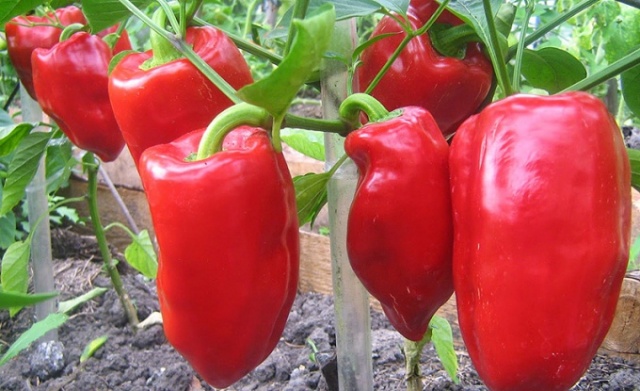 The name of the pepper speaks for itself - the fruits, even with undemanding care, are glossy, large and fleshy. But like any culture, Bogatyr sweet pepper has its own subtleties of cultivation and care
The name of the pepper speaks for itself - the fruits, even with undemanding care, are glossy, large and fleshy. But like any culture, Bogatyr sweet pepper has its own subtleties of cultivation and care
Content
Pepper Bogatyr: grade description
A strong bush of this variety can reach a height of 70 cm, has a spreading crown and a large number of fruits tied. Fruits in the stage of technical maturity have a green hue, but as they ripen, they acquire a red glossy hue and either a cuboid or cone shape. But with any form of fruit, the plant pleases with high productivity, which reaches 8 kg / m2. Of course, this variety has become a favorite of many vegetable growers because of the large fleshy fruits weighing 200 g with a wall thickness of 0.7 mm and a juicy sweet taste, because it is suitable for fresh consumption and canning.
Variety Bogatyr refers to mid-ripening varieties: full ripeness of the fruit is achieved 150-160 days after the appearance of the first sprouts. The hero is unpretentious, resistant to many diseases. The variety bred by Moldovan breeders is perfect for growing in open ground in the southern regions, and in the middle lane it is better to grow it in greenhouses.
More recently, we talked about pepper Atlant.
Advantages of the Bogatyr variety
- Generous productivity.
- Beautiful shape of the fruit.
- Simultaneous germination of seeds.
- Simultaneous ripeness and fruit yield.
- Disease resistance.
- Resistance to temperature extremes.
- Fruiting begins in August and lasts until the frost.
- The variety is cultivated on open and closed ground.
- Pepper seedlings are resistant to light frosts.
- Fruits are extremely rich in vitamin C and trace elements.
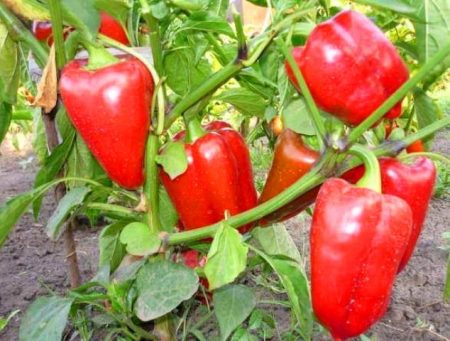
The disadvantages of the variety Bogatyr
The variety does not tolerate dry soil and lack of sun, and is also susceptible to some pests.
Preparing seeds for sowing
- Usually, seeds not older than 3 years are used for sowing, since it is fresh material that has the best germination.
- Then the seeds are kept in a solution of sodium chloride (5%) for half an hour. At the same time, poor-quality seeds will emerge - they are unsuitable for planting.
- Next, the selected seeds are placed in a weak solution of potassium permanganate for disinfection (per 100 ml of water, 1 g of potassium permanganate) for half an hour.
- And the final step will be to immerse the seeds for 3 hours in a growth promoter to increase productivity.
- Now begin to germinate planting material. To do this, the seeds are wrapped in a damp cloth and left for a week at a temperature of 25 ° C. The fabric needs to be moistened from time to time.
Sowing seeds for seedlings
Small containers are suitable for planting seeds, which are good to rinse with a weak solution of potassium permanganate before use.
Soil for planting seeds is prepared from a mixture of fertile soil, compost and sand in a ratio of 2: 1: 1. Seeds begin to be sown in late February or early March.
The containers are filled with prepared soil, placed on top of the seeds at a distance of 2 cm from each other and watered. Top with soil 1 cm layer. Cover the containers with any transparent material and put in a bright warm room. In this case, the room temperature should be around 25 ° C.
About 2 weeks after germination, the clear material is removed. Now the seedlings are hardened: for this, the ambient temperature is reduced to 17 ° C for a week, and then raised again to 25 ° C.
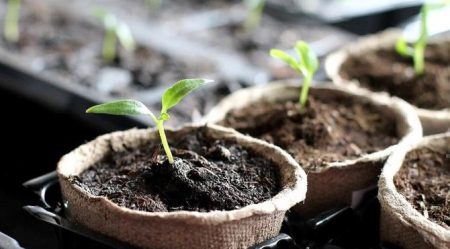
The room with the seedlings should be aired daily, but drafts should be avoided.
2 weeks after the emergence of sprouts, the soil with seedlings is fertilized with a solution of potassium humate (2 l of water and 5 ml of potassium humate) once every 5 days.
Important! Seedlings need lighting 14 hours a day. If there is not enough daylight, you must turn on the lights. Otherwise, the shoots will turn out tall, thin and weak.
Picking seedlings
The procedure is carried out after the appearance of 2 leaves on seedlings, as sweet pepper does not tolerate the transplant. In this case, the following points should be considered:
- Pour seedlings in a container with plenty of water. At this time, small pots are prepared, washed with potassium permanganate and filled with soil, the composition of which is identical for sowing seeds.
- Gently take the sprout by the leaves, pry it off with a spoon from the bottom, and carefully transfer it with the ground to a new container and add soil on top. Be sure to water.
- Pots can be placed on the windowsill, but cover the glass with paper to avoid direct rays.
- The temperature of the pepper medium after diving should not be lower than 15 ° C, otherwise their growth may stop.
- Seedlings need to be fed. For this, you can use ready-made compounds ("Fortress", "Fertika Lux"). The first feeding is carried out 2 weeks after the dive, and the second - after another 2 weeks.
- 3 days before planting in open ground, seedlings should be kept all night on the street for hardening.
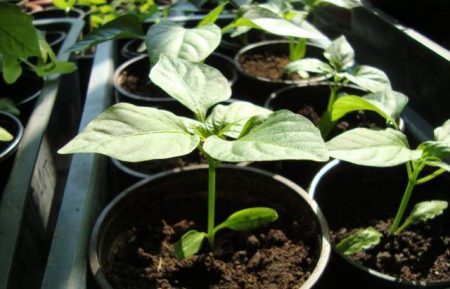
Open transplant
When the seedlings reach a height of 25 cm and the formation of 7 - 8 leaves, it is time to transplant it into the garden. For the Bogatyr variety, loamy or sandy loamy soil and an average daily temperature of 15 ° C are ideal. Ideal precursors for peppers would be cabbage, pumpkin, cucumbers, legumes and carrots.
Before planting, the soil must be prepared in advance. To do this, it must be deeply dug, composted and leveled. Further, pits are made at a distance of 15 cm from each other. The distance between the ridges should be 50 cm. The plant is moved to the holes together with clods of earth. Each well is half asleep with earth, well watered with water and completely asleep.
Watering pepper
Although the Bogatyr variety is quite unpretentious in care, it still needs to be taken care of. Particular attention should be paid to watering. Peppers begin to be watered 5 days after planting with water at room temperature. In this case, the irrigation procedure is carried out in 2 stages. On the first day, one side of the bushes is watered, and the other is loosened. On the second day, water the other side. This will avoid the appearance of crust on the soil.
Harvesting and Storage
Fruits can be harvested at the stage of technical maturity. At the same time, they perfectly tolerate transportation, maintain a good presentation and can be stored in the refrigerator for up to 2 months. Pepper carefully cut with scissors along with the stem.
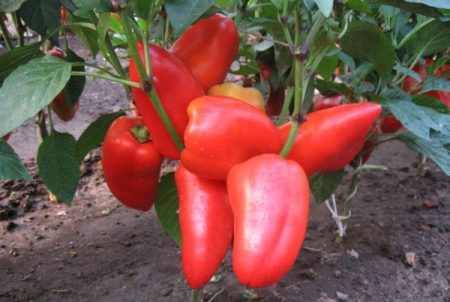
Completely ripened fruits are not subject to long-term storage, therefore they should be used immediately after harvesting.
Reviews of vegetable growers
According to reviews, this variety of pepper is tied quite actively and gives little empty. Always happy with a large harvest of large, sweet and juicy fruits.




 Calorie pepper stuffed with meat and rice - BZHU per 100 grams
Calorie pepper stuffed with meat and rice - BZHU per 100 grams Gorky pepper - the best varieties for open ground
Gorky pepper - the best varieties for open ground Hot pepper seeds - the best varieties for open ground and reviews
Hot pepper seeds - the best varieties for open ground and reviews Capsicum tincture for hair - how to use and reviews
Capsicum tincture for hair - how to use and reviews